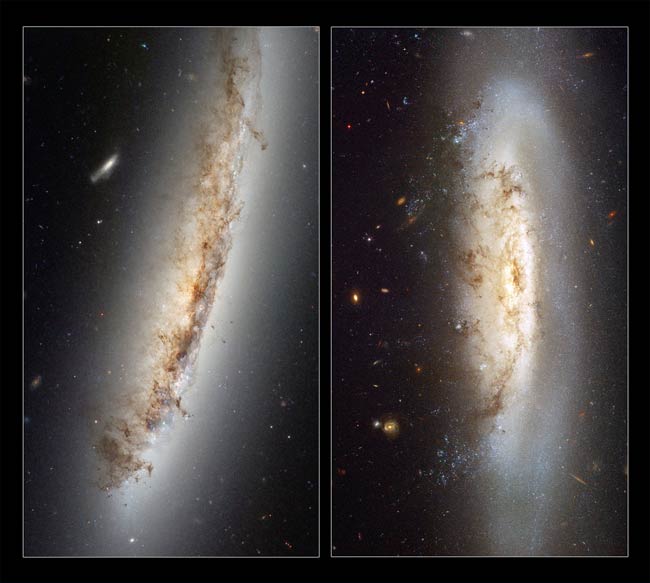Speeding Galaxies Distorted by Space Winds

A new set of images from the Hubble Space Telescope, takenbefore its recent overhaul by astronauts, has revealed strong winds rippingthrough a pair of galaxies, distorting their shape and halting star formation.
The galaxies, members of the Virgo Cluster, are beingaffected by a process called "ram pressure stripping." As galaxies inthe cluster move through hot gas lurking in the gaps between them, winds causedby their swift motion tug and stretch them, resulting in peculiar-lookinggalaxies.
Ram pressure is the drag force that results when somethingmoves through a fluid ? similar to the wind you feel in your face while ridinga bicycle.
In the case of the Virgo cluster, the spiral galaxy NGC 4522- located about 60 million light-years from Earth - is a spectacular example ofa galaxy currently being strippedof its gas content.
The galaxy's rapid motion within the Virgo Cluster resultsin strong winds across the galaxy as the gas within is left behind. Scientistsestimate that the galaxy is moving at more than 6 million mph (10 million kph).A number of newly-formed star clusters that developed in the stripped gas canbe seen in the Hubble image.
The photo highlights the dramatic state of the galaxy, withan especially vivid view of the ghostly gas being forced out of it. Bright bluepockets of new star formation can be seen to the right and left of center. Theimage is sufficiently deep to show distant background galaxies.
A Hubble snapshot of another galaxy called NGC 4402 alsohighlights some telltale signs of ram pressure stripping, such as the curved appearanceof the disk of gas and dust that results from the forces exerted by the heatedgas. Light emitted by the disk illuminates the swirling dust that is beingswept out by the gas.
Get the Space.com Newsletter
Breaking space news, the latest updates on rocket launches, skywatching events and more!
Studying ram pressure stripping helps astronomers betterunderstand the mechanisms that drive the evolution of galaxies, as well as howthe rate of star formation is suppressed in very dense regions of the universe.
Both new images were taken by Hubble's Advanced Camera forSurveys (ACS) before it suffered from a power failure in 2007. In May,astronauts on the STS-125 mission of the space shuttle Atlantis visited Hubblefor the final time, overhauling its equipment, installing new instruments, andrestoring the ACS to service.
NASA and the European Space Agency released the firstnew photographs from the new-and-improved Hubble earlier this month
?? SPACE.comShow: Hubble's Final Shuttle Service Call
?? SPACE.com'sComplete Coverage of the Hubble Space Telescope
?? Images? Hubble's Latest Views of the Universe: Part 1, Part2
Join our Space Forums to keep talking space on the latest missions, night sky and more! And if you have a news tip, correction or comment, let us know at: community@space.com.

Space.com is the premier source of space exploration, innovation and astronomy news, chronicling (and celebrating) humanity's ongoing expansion across the final frontier. Originally founded in 1999, Space.com is, and always has been, the passion of writers and editors who are space fans and also trained journalists. Our current news team consists of Editor-in-Chief Tariq Malik; Editor Hanneke Weitering, Senior Space Writer Mike Wall; Senior Writer Meghan Bartels; Senior Writer Chelsea Gohd, Senior Writer Tereza Pultarova and Staff Writer Alexander Cox, focusing on e-commerce. Senior Producer Steve Spaleta oversees our space videos, with Diana Whitcroft as our Social Media Editor.









